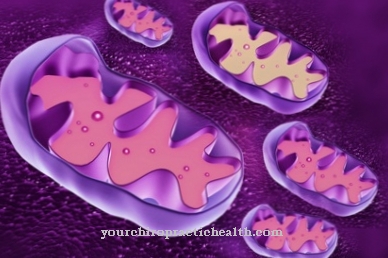As Dorsiflexion are called regular specific movements on the hand and foot. The term only appears alternatively on the toes and on the spine; other terms are more common there.
What is dorsiflexion?

The term dorsiflexion comes from the anatomical nomenclature. It is made up of two Latin words. 'Dorsal' indicates the direction of movement: 'towards the back' ('dorsum'). It runs from the front bottom to the back top. 'Extension' means 'stretching' and is the opposite of 'flexion' (flexion).
Dorsiflexion is used to describe the extension of the hand and foot. It describes the lifting of the two parts of the body in the wrist and the upper ankle.
The imaginary axis of movement runs transversely to the body through the ankles in the lower leg and through the proximal carpal row. Starting from the zero position, the hand or foot describe a circular path on which they approach the forearm or the lower leg. A special feature of the foot is that the zero position is the 90 ° position. The opposite direction on the hand is called palmar flexion and on the foot plantar flexion.
The usual definition of flexion and extension creates difficulties with dorsiflexion. As described in other joints, it is not accompanied by an increase in the joint angle. That is why the term dorsiflexion is sometimes used in the literature. For the movements in the toes and the spine, extension has established itself as the common term, dorsiflexion is rarely used there.
Function & task
The dorsiflexion has an important role in many activities, both as a free movement and as a stability component. All activities in which the hand grasps and holds something require a stable position in the wrist with slight dorsiflexion. This functional position gives the joint the necessary stability, which is the basis for the optimal development of strength in the fingers.
The muscles that are active in this position are not only challenged to hold heavy weights, but more often functions with little load, with simultaneous movement of the entire arm and fingers. Typical examples are long typing activities with the keyboard or using the mouse.
As a free movement, dorsiflexion in the wrist plays an important role in all backward movements of the hand. The entire articulated chain is brought into a pre-stretched position, so that the subsequent throwing or flapping movement can be started more efficiently.
A typical movement sequence in sport, in which the whole chain from the shoulder joint, over the elbow joint to the wrist and the fingers is brought into a pre-stretch, is the volleyball swing before the blow. The same applies to overhead volleyball in tennis, with the difference that the fingers are closed by the handle.
The dorsiflexion of the foot has its most important function when walking. Together with the toe extensors, the foot is raised in the swing leg phase so that the leg can be moved forward freely and without interference. This form of activity occurs more intensely when the pace is increased. When running and especially when sprinting, legs and feet are lifted significantly more off the ground than when walking. The function of the executing muscles is challenged even more.
You can find your medication here
➔ Medicines for painIllnesses & ailments
Raising hands and feet can be affected by various injuries or illnesses. Nerve lesions are a specific cause of weakness in the executing muscles and a resulting deficit in dorsiflexion.
Damage to the radial nerve leads to the failure of the dorsal extensors of the hand and the appearance of the so-called drop hand. In the case of complete paralysis, lifting is no longer possible at all; in the case of an incomplete, residual functions are still present. The nerve damage can be caused by injuries such as broken bones, but also pressure loads from a cast that is too tight and neurological diseases such as hemiplegia or polyneuropathy.
The complementary phenomenon on the foot is the so-called dorsiflexion weakness. It can be caused by a lesion of various nerve branches that supply the dorsal extensors. Causes for this can be the same as on the arm. More often than in the upper extremities, pressure damage from a herniated disc is the reason for this loss of function, as it presses the nerve root.
The lack of or limited dorsiflexion is particularly noticeable when walking or running. The foot cannot be lifted or can only be lifted a little and drags over the ground during the swing leg phase. It becomes dangerous if the sensitivity is disturbed at the same time. Sensitivity disorders of this type occur in neurological disorders, such as a stroke, polyneuropathy and as a result of a herniated disc.
All forms of muscle disease sooner or later lead to limited dorsiflexion of the hand and foot. These include muscular dystrophies and amyotrophic lateral sclerosis.
The so-called equinus foot represents a special form of restriction of foot mobility. The Achilles tendon is massively shortened by immobilization, but more often by prolonged inactivity. As a result, the movement into dorsiflexion becomes increasingly less and at some point it is no longer possible.
A typical overload syndrome that affects the dorsal extensors of the hand is the so-called tennis elbow, in which the origins of the muscles are painfully irritated.

























.jpg)

.jpg)
